

Structuring Small Business: How Internal Structure Affects Growth - When looking ahead to the growth of your business, it makes sense to focus on the strategic issues—the where’s, when’s and how’s.
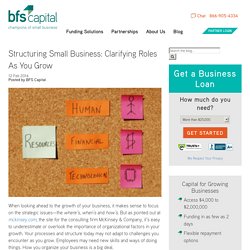
But as pointed out at mckinsey.com, the site for the consulting firm McKinsey & Company, it’s easy to underestimate or overlook the importance of organizational factors in your growth. Your processes and structure today may not adapt to challenges you encounter as you grow. Employees may need new skills and ways of doing things. How you organize your business is a big deal. McKinsey describes three of the most common problem areas—pitfalls to be aware of— along with real-life examples of businesses that faced them: Stifling structures. In wanting to avoid getting tangled up in structure and bureaucracy, small business owners can go in the opposite direction, especially in the early years, resisting anything that smacks of organizational structure or formal practices.
Evolution and Revolution as Organizations Grow. This article originally appeared in the July–August 1972 issue of HBR.

For the article’s republication as a Classic, the author has removed some outdated material from the opening sections. He has also written a commentary, “Revolution Is Still Inevitable,” to update his observations. Key executives of a retail store chain hold on to an Organizational structure long after it has served its purpose because the structure is the source of their power. The company eventually goes into bankruptcy. A large bank disciplines a “rebellious” manager who is blamed for current control problems, when the underlying causes are centralized procedures that are holding back expansion into new markets.
The problems at these companies are rooted more in past decisions than in present events or market dynamics. The Five Stages of Small Business Growth. Categorizing the problems and growth patterns of small businesses in a systematic way that is useful to entrepreneurs seems at first glance a hopeless task.

Small businesses vary widely in size and capacity for growth. They are characterized by independence of action, differing organizational structures, and varied management styles. Yet on closer scrutiny, it becomes apparent that they experience common problems arising at similar stages in their development. These points of similarity can be organized into a framework that increases our understanding of the nature, characteristics, and problems of businesses ranging from a corner dry cleaning establishment with two or three minimum-wage employees to a $20-million-a-year computer software company experiencing a 40% annual rate of growth.
The framework also provides a basis for evaluating the impact of present and proposed governmental regulations and policies on one’s business. Who Cares About Costs? Here's How to Structure Your Business to Last. This story appears in the August 2013 issue of Entrepreneur.
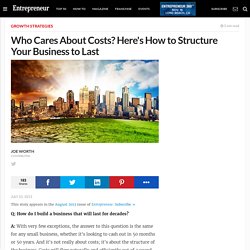
Subscribe » Q: How do I build a business that will last for decades? A: With very few exceptions, the answer to this question is the same for any small business, whether it's looking to cash out in 50 months or 50 years. And it's not really about costs; it's about the structure of the business. Costs will flow naturally and efficiently out of a sound structure.
Many public companies operate shortsightedly, pumping up their quarterly numbers to boost their stock prices, with sometimes disastrous long-term results. 4 Essential Steps to Managing Growth. A funny little thing happens on the road to success.
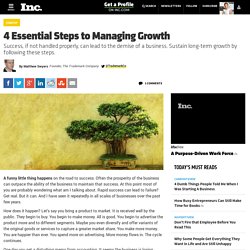
Often the prosperity of the business can outpace the ability of the business to maintain that success. At this point most of you are probably wondering what am I talking about. Rapid success can lead to failure? Get real. But it can. How does it happen? One day you get a disturbing memo from accounting. Your first reaction is typically one of disbelief and anger. Often as entrepreneurs we become so focused on bringing the product to market, advertising the product, and selling the same that we fail to grow all aspects of the business in unison. Don’t think this can really happen? However, over the past two years this modern titan has experienced a dramatic fall. Preparing your organization for growth. Companies that address their organizational weaknesses as they implement growth strategies give themselves an advantage.
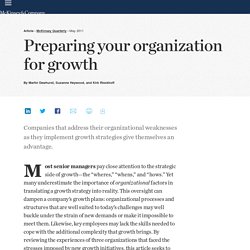
Most senior managers pay close attention to the strategic side of growth—the “wheres,” “whens,” and “hows.” Yet many underestimate the importance of organizational factors in translating a growth strategy into reality. This oversight can dampen a company’s growth plans: organizational processes and structures that are well suited to today’s challenges may well buckle under the strain of new demands or make it impossible to meet them. Likewise, key employees may lack the skills needed to cope with the additional complexity that growth brings. By reviewing the experiences of three organizations that faced the stresses imposed by new growth initiatives, this article seeks to illustrate such “pain points” and suggests some approaches for coping with them. 1.
Researchers: What Is the Structure of a Successful Startup? Young companies that adopt structured systems to run their operations in their early years grow three times faster than competitors and have a lower rate of CEO turnover, according to an award-winning research paper.
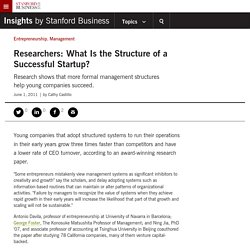
"Some entrepreneurs mistakenly view management systems as significant inhibitors to creativity and growth" say the scholars, and delay adopting systems such as information-based routines that can maintain or alter patterns of organizational activities. How to structure your startup as the company grows. A lot of startups share the same mythical origin story — a couple close friends plotting and scheming in a basement or garage, trying to build a company that will change the world.

But, if they're lucky, the story doesn't stop there. As a company grows, it transitions from two founders to a team and moves out of the garage and into a real office. While this is an exciting transition and, usually, a positive sign, it is also the time that certain growing pains can begin to emerge. One such problem that startups can run into is organization structure, or how a company defines roles, teams, and supervision. By carefully planning for that growth, startups can avoid some common headaches. Here are considerations for startup founders as they strategize on organizational structure. Defining roles.